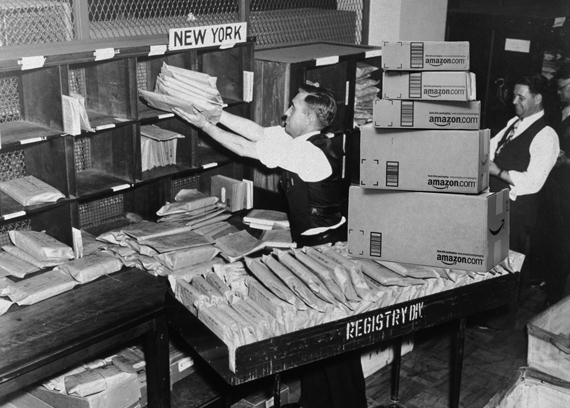Trending
Boxed in: NYC landlords struggling to deal with residents’ online shopping addiction
Online sales continue to grow, forcing owners to redesign package rooms or charge fees

Online shopping is designed to make life easier — except for landlords.
Call it a game of logistics. Property owners are grappling to adapt to a deluge of tenant packages from the likes of Amazon, Etsy, Blue Apron and Zappos, which have rendered traditional apartment building package rooms desperately inadequate.
In some instances, that simply means renovating or expanding package to support a bigger haul. In others, where expansion is not a possibility, it means finding smart ways to quickly turn over packages and avoid backlogs. Both options come at an expense.
And, when it comes to new development, real estate companies are getting serious about strategizing their package storage approach very early in the pre-development planning process.
“Lessons have certainly been learned from the previous cycle of luxury development,” said Elisa Orlanski Ours, a senior vice president of planning and design at new development marketing firm Corcoran Sunshine. “As buildings moved from presales to immediate occupancy and American retail culture shifted, we learned that some buildings simply didn’t allocate enough space for package storage or consider how to inform residents of a delivery.”
Online sales in the U.S. are slated to grow to $370 billion this year, up from just $231 billion in 2012, according to Forrester Research. Amazon’s North American sales increased 25.2 percent in 2016.
And landlords are struggling to keep up.
At 298 Mulberry Street, a 96-unit rental building in Noho, landlord Broad Street Development recently expanded its package room by 30 percent and added layers of shelving going up 11 feet high in order to accommodate a massive increase in package volume, said property manager Gayle Kennedy.
“We would probably would have built even larger if we could have, just knowing that this online shopping trend is going to continue and get greater,” Kennedy said.
But even that wasn’t enough to ease the package pressure. Rather, in a bid to get things moving, Broad Street has introduced a monthly fee of $25 for residents to have boxes delivered directly to their apartment doors, alleviating space issues downstairs. The fee component has helped Broad Street to hire a dedicated new staff member to make the deliveries, Kennedy said.
Similarly, at the Related Companies’ Carnegie Park development uptown, residents can request that their packages be delivered directly to their apartments, Ours said.
“The genesis of the program was providing enhanced service and lifestyle,” she said, “but it has the added benefit of moving deliveries out of storage areas faster.”
Package woes are certainly not new.
In 2015, Houston-based real estate investment trust Camden Property Trust famously ceased accepting parcels at all 169 of its U.S. properties, citing a 50 percent increase year over year in deliveries. It estimated that each package resulted in 10 minutes of lost productivity for its staff and that handling the torrent of boxes was costing it $3.3 million a year.
The decision was polarizing and some residents even penned a Change.org petition, lobbying against the policy change.
Designing package rooms for especially large buildings involves plenty of pre-planning — and can come at the expense of signing a retail tenant on the lower floors or allocating space for lounging, sources said.
“Everything is always a tradeoff,” said Mitchell Wasser, director of leasing at Metro Loft Management, which is developing a 565-unit rental complex at 180 Water Street in the Financial District.
“We worked diligently to design a gorgeous lobby, and didn’t want to have packages overflow into it,” he said. In the end, Metro Loft allocated three package storage rooms on the ground floor to make sure that overflow wouldn’t be an issue.
“The first storage room is designated for large packages and will include a refrigerator for cold storage. The second storage room is located behind the security desk for easy access and is designated for smaller packages. The third storage room is located with the valet and is designated for dry cleaning and additional smaller packages,” Wasser said.
Across HFZ Capital Group‘s New York portfolio, the landlord has instituted a 24-hour rule, whereby residents must pick up their packages within a day of the delivery. If they don’t, the doormen will call and request permission to enter their apartments to deliver the packages.
The company has also reconfigured the lobby at several of its projects, Including 11 Beach Street in Tribeca, to allow for more package space, said Tatiana Nizguretsky, managing director of property management at HFZ.
“We have new developments that are 2.5 years from fruition and we’re already thinking about package space, because the demand is only going to increase by then,” she said.
But there’s no consistent formula when it comes to determining how much space landlords will require.
“In planning, we often look to completed, operational condos and assess how effective their programming was based on the number of residences,” said Corcoran Sunshine’s Ours. “We’ll speak with management companies, brokers and buyers to understand how a building functions in its maturity.”




